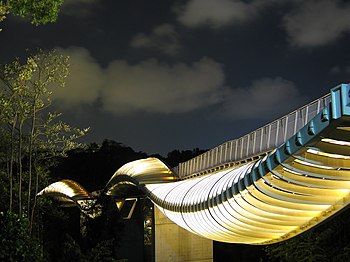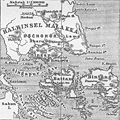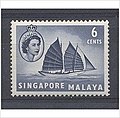Portal:Singapore
 Map of Singapore Singapore, officially the Republic of Singapore, is an island country and city-state in Southeast Asia. The country's territory comprises one main island, 63 satellite islands and islets, and one outlying islet. It is about one degree of latitude (137 kilometres or 85 miles) north of the equator, off the southern tip of the Malay Peninsula, bordering the Strait of Malacca to the west, the Singapore Strait to the south along with the Riau Islands in Indonesia, the South China Sea to the east, and the Straits of Johor along with the State of Johor in Malaysia to the north.
In its early history, Singapore was a maritime emporium known as Temasek and subsequently a major constituent part of several successive thalassocratic empires. Its contemporary era began in 1819, when Stamford Raffles established Singapore as an entrepôt trading post of the British Empire. In 1867, Singapore came under the direct control of Britain as part of the Straits Settlements. During World War II, Singapore was occupied by Japan in 1942 and returned to British control as a Crown colony following Japan's surrender in 1945. Singapore gained self-governance in 1959 and, in 1963, became part of the new federation of Malaysia, alongside Malaya, North Borneo, and Sarawak. Ideological differences led to Singapore's expulsion from the federation two years later; Singapore became an independent sovereign country in 1965. After early years of turbulence and despite lacking natural resources and a hinterland, the nation rapidly developed to become one of the Four Asian Tigers. As a highly developed country, it has one of the highest PPP-adjusted GDP per capita. It is also identified as a tax haven. Singapore is the only country in Asia with a AAA sovereign credit rating from all major rating agencies. It is a major aviation, financial, and maritime shipping hub and has consistently been ranked as one of the most expensive cities to live in for expatriates and foreign workers. Singapore ranks highly in key social indicators: education, healthcare, quality of life, personal safety, infrastructure, and housing, with a home-ownership rate of 88 percent. Singaporeans enjoy one of the longest life expectancies, fastest Internet connection speeds, lowest infant mortality rates, and lowest levels of corruption in the world. It has the third highest population density of any country, although there are numerous green and recreational spaces as a result of urban planning. With a multicultural population and in recognition of the cultural identities of the major ethnic groups within the nation, Singapore has four official languages: English, Malay, Mandarin, and Tamil. English is the common language, with exclusive use in numerous public services. Multi-racialism is enshrined in the constitution and continues to shape national policies. Singapore is a parliamentary republic and its legal system is based on common law. While the country is de jure a multi-party democracy with free elections, the government under the People's Action Party (PAP) wields widespread control and political dominance. One of the five founding members of ASEAN, Singapore is also the headquarters of the Asia-Pacific Economic Cooperation Secretariat, the Pacific Economic Cooperation Council Secretariat, and is the host city of many international conferences and events. Singapore is also a member of the United Nations, the World Trade Organization, the East Asia Summit, the Non-Aligned Movement, and the Commonwealth of Nations. (Full article...)Selected article - Kent Ridge Park is a 47-hectare public park located in Kent Ridge, Singapore, between the National University of Singapore and the Singapore Science Park. Due to its undisturbed habitat and abundant plant life, it is a popular venue for bird-watchers and eco-tourists. During the Second World War, a hill in the park was the site of one of the last and fiercest battles fought by the Malay Regiment against the invading Japanese army, the Battle of Bukit Chandu (also known as the Battle of Pasir Panjang), 12–14 February 1942. (Full article...) Selected picture Henderson Waves, a 274-metre (900-foot) long pedestrian bridge connecting Mount Faber Park and Telok Blangah Hill Park. At 36 metres (120 feet) above Henderson Road, it is the highest pedestrian bridge in Singapore. Read more... General imagesThe following are images from various Singapore-related articles on Wikipedia.
Selected biography -Rex Anthony Shelley (27 October 1930 – 21 August 2009) was a Singaporean author. A graduate of the University of Malaya in Malaysia and Cambridge trained in engineering and economics, Shelley managed his own business and also worked as member of the Public Service Commission (PSC) for over 30 years. For his service, he was conferred the Bintang Bakti Masyarakat (Public Service Star) by the Government of Singapore in 1978, and an additional Bar the next year. Shelley started writing fiction late in life, publishing his first novel, The Shrimp People, in 1991 at the age of sixty one. The first substantial work by a Singaporean writer about the Eurasian community in Singapore, it was highly commended by The Straits Times and won the 1992 National Book Development Council of Singapore (NBDCS) Award. The books People of the Pear Tree (1993), Island in the Centre (1995) and A River of Roses (1998), on the same theme, followed within a decade; respectively, they won NBDCS Highly Commended Awards in 1994 and 1996, and the Dymocks Singapore Literature Prize in 2000. In 2007 he was the Singaporean winner of the S.E.A. Write Award. Critics have responded positively to his writing, noting its "passionate, humane" style, and observing how his breadth of life experience gave rise to a talent for characterisation plus an ability to blend "a sharp sense of observed commentary with historical detail". (Full article...) Did you know (auto-generated)
In this month
More did you know -
Selected panoramaThe National Stadium (Chinese: 国家体育场; Malay: Stadium Nasional Singapura) is located in Kallang. Opened in July 1973, the National Stadium was officially closed on June 30, 2007 and will be demolished in late 2008 to make way for the Singapore Sports Hub which is expected to open in 2011. Singapore topicsRelated portalsSoutheast Asia Other Countries Tasks
CategoriesWikiprojectsAssociated WikimediaThe following Wikimedia Foundation sister projects provide more on this subject:
Discover Wikipedia using portals |






























































